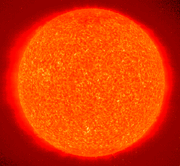No edit summary |
No edit summary Tag: Visual edit |
||
| Line 4: | Line 4: | ||
To counter the core's collapse the outer envelope expands causing the temperature to drop at the surface but also increasing surface area and thereby the luminosity of the star. Within the core temperatures will rise to begin fusion of helium into carbon. A shell around the core will rise to such a temperature as to ignite further hydrogen fusion in that region of the star. The helium produced falls onto the core where it can be used as fuel. |
To counter the core's collapse the outer envelope expands causing the temperature to drop at the surface but also increasing surface area and thereby the luminosity of the star. Within the core temperatures will rise to begin fusion of helium into carbon. A shell around the core will rise to such a temperature as to ignite further hydrogen fusion in that region of the star. The helium produced falls onto the core where it can be used as fuel. |
||
| − | This time in the life of a Red Giant is very short compared to the main sequence lifetime, only a few million years. When this stage ends, the star will shed its outer layers and become a [[White dwarf]] |
+ | This time in the life of a Red Giant is very short compared to the main sequence lifetime, only a few million years. When this stage ends, the star will shed its outer layers and become a [[White dwarf]]. |
Revision as of 14:47, 4 September 2019

When the star has run out of hydrogen fuel to fuse into helium within its core the core will begin to collapse and heat some more.
To counter the core's collapse the outer envelope expands causing the temperature to drop at the surface but also increasing surface area and thereby the luminosity of the star. Within the core temperatures will rise to begin fusion of helium into carbon. A shell around the core will rise to such a temperature as to ignite further hydrogen fusion in that region of the star. The helium produced falls onto the core where it can be used as fuel.
This time in the life of a Red Giant is very short compared to the main sequence lifetime, only a few million years. When this stage ends, the star will shed its outer layers and become a White dwarf.
| This article is a stub, and may need more information. You can help Space Wiki by expanding it. |
|---|